The last Japanese tankette
Just like so many other countries, the Japanese military officials were ensnared by the tankette fad, during the thirties. The first model developed was the Jyu-Sokosha (1931), then came the mass-produced Type 94 TK (1933). The last evolution of the Japanese tankette was developed by the Hino Motors Company around a 4-cylinder diesel engine, and carried a 37 mm (1.46 in) gun, which was far more potent than the usual machine-gun. This prototype, built in 1936, was the very basis for the new Type 97, or 1938 according to the imperial calendar, after many tests and changes demanded by the Army. The final prototype, delivered in November, and finally accepted, entered full-scale production in 1938. They were designed to give additional fire support to infantry divisions, as well as many other tasks.Design of the Type 97 TK
The 1937 prototype was still largely based on the previous Type 94, and bore many similarities, starting with the drivetrain, although the engine was now located at the rear. Because of this, the fighting compartment was pushed forward, and the turret was now roughly in the middle. This put the driver and commander in close proximity, easing communication. The hull was still riveted, and the interior covered by heat absorbing asbestos sheets. The 37 mm (1.46 in) Type 94 main gun (L/36.7) was supplied with 94 rounds, had an elevation of -15/+20°, a 600 m/s (660 yd/s) muzzle velocity and could penetrate 45 mm (1.77 in) of armor at 300 meters (330 yd). This gun model, also shared with the Type 95 Ha-Go, was always in short supply, and many TKs ended with a Type 97 machine gun instead. Protection was limited to 16 mm of armor (0.63 in) on the front and turret, and was found inadequate against the HE rounds of the mainstream US M2 0.50 cal (12.7 mm) machine guns. The only known variant was the Type 98 So-Da, an ammo supply vehicle and APC.Operational history
Tactically, 6 tankettes were given to each IJN infantry division. They were primarily intended as scout vehicles, spearheading assaults. They also provided additional firepower where it was needed, and also supplied and/or towed light guns. Each was equipped with a reinforced towing hook. When production ended in 1941-42, a total of 596 or 557, depending on the source, had been produced, without any notable change. Most saw action in China, in various areas, until 1945. They were opposed by the Chinese National Revolutionary Army's few Italian CV-33 tankettes and French FT tanks, which did not seriously threaten the Type 97. However, on the Russo-Mongolian border they suffered heavy casualties, succumbing to the Russian high velocity 45 mm (1.77 in) gun, shared by the BT-5 and BT-7. During first months of the war in the Pacific, their lightweight characteristics were taken full advantage of when crossing small bridges or using wooden ferries. Their small dimensions allowed them to closely follow the infantry on narrow roads and tracks. They soldiered in Malaya, taking part in the fall of Singapore. Many were shipped to the Philippines, rarely opposed to American armor. But, when it was the case the M3 light tanks proved deadly.
Type 97 Te-Ke specifications |
|
| Dimensions (L-w-h) | 3.70 x 1.80 x 1.77 m (12 x 5.10 x 5.9 ft) |
| Total weight, battle ready | 4.7 tons (10,360 lbs) |
| Crew | 2 (driver, gunner/commander) |
| Propulsion | Hino Motors diesel air-cooled 4-cyl engine, 48 hp (36 kW) |
| Top speed | 42 km/h (26 mph) |
| Armor | 4 to 16 mm (0.16-0.63 in) |
| Armament | 37 mm (1.46 in) Type 94 gun or 7.7 mm (0.3 in) Type 97 machine-gun |
| Range (at cruise speed) | 250 km (155 miles) |
| Total production | 596 (557 ?) |
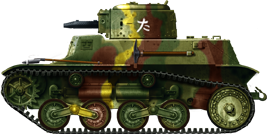
Type 97 Te-Ke, the machine-gun version, unknown infantry unit, Burma, 1942. Due to the shortage of 37 mm (1.46 in) guns, many were delivered in this undergunned configuration.
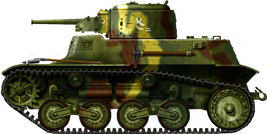
Type 97 Te-Ke gun version, Malaya, January 1942. This gun was also mounted on the Type 95 Ha-Go light tank.
Gallery
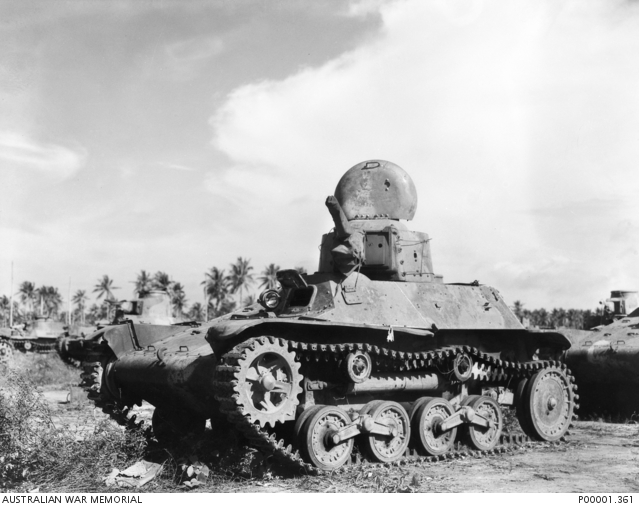
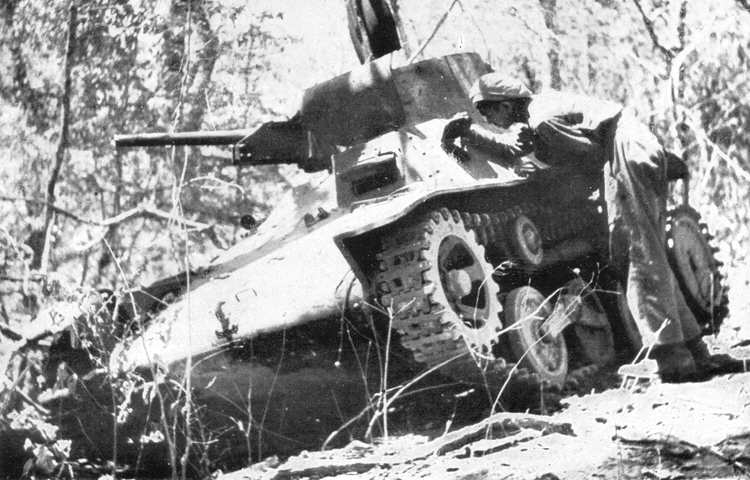
 Imperial Japanese Army (1935-37) Tankette - 823 built
Imperial Japanese Army (1935-37) Tankette - 823 built
The most prolific Japanese tankette
By 1930, there was a strong belief that the tankette was the perfect means to motorize entire army groups with half the cost of normal tanks. This cheap asset was appreciated by many countries, which quickly built or bought swarms of these machines. The best-seller, at the time, was the British Vickers designed Carden-Loyd Mk.VI. A Japanese army commission was mandated to purchase several British and French models, in order to compare their respective performances. They had already tested and put in service Renault FT (as the Ko Gata), and heavily tested the Carden-Loyd Mk.VI. However, the IJN commission decided to produce a domestic design, better able to fit the army's requirements. At first, the process led to the Type 92 Jyu Sokosha, a large tankette almost exclusively used by the cavalry. But, as the army decided to have its own tankette, a new lighter model, usable within infantry companies was requested, intended to provide support when needed, either with firepower or supplies. The first design, dating back from 1932, was revised by the Tokyo Gas and Electric Industry, and new plans in 1933 led to a prototype the following year. This led to the Type 94 TK, for Tokushu Keninsha, "special tractor". This was to be a versatile design, capable of scouting operations, infantry support and transport. It was also designed to replace the already existing fleet of armored cars in Manchukuo, as an off-road vehicle.Design of the TK
The Type 94 was a minimalist design. A light tracked hull with a small turret fitted at the rear, armed with a single machine-gun, with the engine at the front and driver to the right. The concept was, apparently, inspired by the Carden-Loyd Mk.VI. The hull was riveted, and the Mitsubushi air-cooled engine developed 35 bhp at 2500 rpm, for a total of 9.5 bhp/ton. The crew was protected from heat by asbestos insulation. The speed was the same as that of the original British design. The commander, who also acted as gunner, sat in the turret, which was manually traversed, by pushing a shoulder against the machine-gun. There was also a storage compartment at the rear, accessible through a large door. The original armament, a Type 91 6.5 mm (0.25 in) gas-operated machine gun (1980 rounds), was later replaced by a more powerful Type 92 7.7 mm (0.31 in) model during production and in service.The gun was protected by an armored mantlet. The suspension system comprised two bogies, each supporting two rubber road wheels, combined with a Japanese bell crank reinforced by horizontal compression springs, invented by Major Tomio Hara. The drive sprocket was at the front and the idler wheel was at the rear, and the narrow track was supported on two rubber-filled return rollers. Like many narrow-tracked fast tanks, these were prone to throwing off their tracks during high-speed turns. To fix this issue, a later variant had a larger idler wheel, and the last received a complete redesign of the suspension. But the problem remained until the end of production in 1937.
Type 94 TK variants and derivatives
The Type 94s were relatively homogeneous, as they were built by the same contractor, Hiro Motor Company. The most notable difference is the suspension system, with the first two models differing only by having a small or big idler wheel, while the last had a revised suspension and longer chassis, now 3.35 m (11 ft) long. Other variations include the machine-gun model, with or without protective mantlet, and minor finishing details and equipment, like searchlights projectors and tools fixations.The Type 94 differed from other tankettes by having a towing device installed and a tracked trailer that carried supplies. A single prototype was tested with a diesel engine, placed on the right, with the driver displaced to left side of the hull. Trials and experiments led to the development of the Type 97 Te-Ke, which succeeded it. The TK chassis was used for several variants, including a Disinfecting Vehicle, Gas Scattering Vehicle, Pole Planter, and Cable Layer.
The Type 94 tankette in action
The first tankettes were accepted in service in 1934. They were deployed in small independent tankette companies, in order to act as "flying squads". They quickly provided infantry support where needed, and were used for reconnaissance. In China, a 118-man company had four platoons of four tankettes. Later on, one company was attached to each infantry division, comprising six Type 94s. Production was an average 250 per year, from 1935 to 1937, at 50,000 yen apiece, which is less than half the cost of a single Type 89 medium tank.In operations, the tankette proved to be useful, and took its place in many tactical concepts in China. For these reasons, they were still used as such by 1941, although now obsolete. First engagements came in 1939 on the Soviet-Chinese-Mongolian frontier, notably at Nomonanh. Most of these tankettes remained in China (Hebei, Chahar, Shanghai, Taierchwang, Hsuchou) and Manchukuo (Nomonhan and Hsinking). However, many others were found wherever IJN infantry divisions were sent, which included most of the Pacific and Oceania, including Burma, the Dutch East Indies, Philippines and most southern Pacific major islands, like Guadalcanal.
A few were also assigned to IJN marines, where US marines encountered them. They fell easy prey to .50 caliber (12.7 mm) machine-gun fire, grenades, bazookas, and light tanks like the M3. Many were captured at Kwajalein, belonging to the 2nd Battalion of Army, 1st Sea-mobile Brigade. Others were seized by Anzac forces at Java, formerly of the 2nd, 3rd and 48th Recon Regiment and 56th Infantry Group Tankette Unit, and on Timor, of the 38th Division Tankette Company. Many Type 94 tankettes were still active in August 1945, when the USSR invaded Manchukuo.
Links
The TK on Wikipedia
Type 94 TK specifications |
|
| Dimensions | 3.08 x 1.62 x 1.62 m (10.10 x 5.3 x 5.3 ft) |
| Total weight, battle ready | 3.5-3.58 tons (7716 lbs) |
| Crew | 2 (driver, commander/machine-gunner) |
| Propulsion | Mitsubishi air-cooled 4-cyl petrol engine, 32 hp (24 kW) |
| Speed | 40 km/h (25 mph) |
| Armor | 4 mm (0.15 in) roof and bottom, 12 mm (0.47 in) glacis and sides |
| Armament | 6.5 mm (0.25 in) Type 91 or 7.7 mm (0.303 in) Type 92 machine-gun |
| Range | 200 km (162 miles) |
| Total production | 823 |
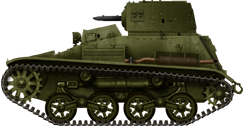
Type 94 TK tankette, early model, Hebei Province, China, 1935.
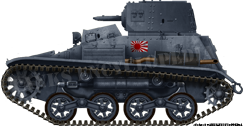
Type 94 TK tankette of the IJN Marine forces, Shanghai, 1937.
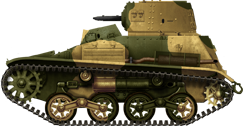
Early version Type 94 TK tankette, Nomonhan plateau, August 1939.
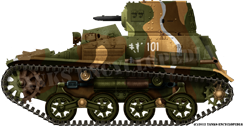
Type 94 TK, early production model without rear hook, scout unit, Burma, 1942.
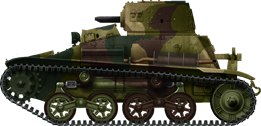
Late model Type 94 TK tankette, with a lengthened chassis, new large idler wheel and a Type 92 7.7 mm (0.3 in) machine-gun. 48th Recon Regiment, Java, 1942.
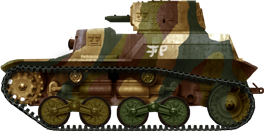
Last evolution of the Type 94 TK tankette. This was almost a completely new model, with the late type long hull and large idler wheel, and a completely reworked suspension system. It was the blueprint for the next Type 97 tankette. 2nd Battalion of the IJA, Kwajalein, 1943.
Gallery
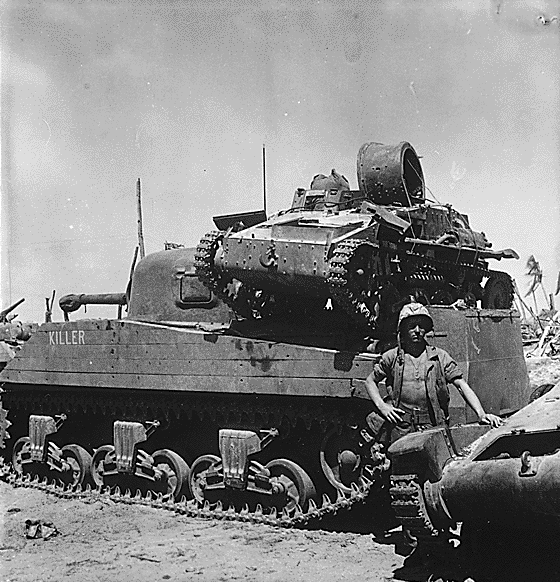
A captured Type 94 TK carried by a M4 Sherman, at Kwajalein. You can easily get a sense of its size from this image - Credits: Wikipedia.
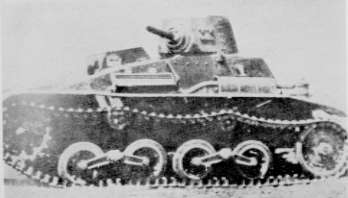
A late production Type 94 TK, with a longer hull and larger idler wheel, in order to cope with the tracks being throwing off at high speed turns - Credits: IJN archives

Get the Poster of the ww2 Imperial Japanese Army Tanks and support us !

WW2 Tanks




























WW2 tanks posters

All Tiger tanks liveries.

Panther liveries and variants

WW2 Armour - All tanks











Tanks aces and single tanks series

Find more there

Museums, Movies, Books & Games
The Tanks and Armor in pop culture
Tanks and armored vehicles in general are only really grasped when seen first person: The mass, the scale, it's all there. Explore also the way tanks were covered in the movie industry, in books and in video games.Movies:
Best tanks movie on warhistoryonline.com
On imdb.com
On bestsimilar.com/
miltours.com
liveabout.com/
watchmojo.com
Video Games:
pcgamesn.com
historyhit.com
levvvel.com
vg247.com/best-tank-games
mmobomb.com/
alienwarearena.com
